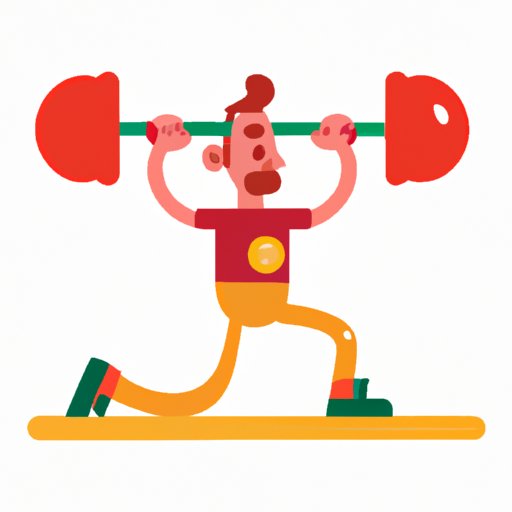I. Introduction
Physical activity is essential for leading a healthy lifestyle. It is crucial to understand the benefits it has on your body and mind. This article aims to provide an informative guide to physical activity, from its definition to creating a workout regimen. It is suitable for anyone looking to start a more active lifestyle or just curious about the benefits of physical activity.
II. Moving For Your Health: Understanding Physical Activity
Physical activity is any movement that requires energy expenditure. It includes activities such as running, swimming, cycling, and even household chores like cleaning or gardening. The World Health Organization recommends at least 150 minutes of moderate-intensity physical activity per week for adults.
Physical activity has numerous benefits for overall health, including reducing the risk of chronic diseases like obesity, diabetes, and heart disease. It also helps in maintaining healthy bones, muscles, and joints and promoting psychological well-being.
This article covers the importance of physical activity, especially in a sedentary lifestyle, getting started with physical activity, the science behind it, designing a perfect workout regimen, personal success stories, different types of exercises, and how they affect the body – all tailored towards changing your life for the better.
III. The Importance of Physical Activity in a Sedentary World
Sedentary lifestyle, characterized by a lot of sitting or lying down, has devastating effects on health. Studies have linked sedentary behavior to an increased risk of chronic diseases, including obesity, diabetes, and cardiovascular disease. It can also lead to poor mental health.
In contrast, physical activity helps reduce the risk of chronic diseases while improving mood and cognitive function. It reduces the risk of premature death from any cause and helps in enhancing overall well-being. According to the WHO, physical inactivity is the fourth leading risk factor for global mortality.
It is essential to find ways to incorporate physical activity into daily routine. Simple solutions like taking the stairs instead of the elevator, parking farther away from the entrance, or taking a short walk during lunch break can be significant in achieving regular physical activity.
IV. Get Moving: A Beginner’s Guide to Physical Activity
Starting from scratch can be challenging, but it is never too late to start a more active lifestyle. It is critical to choose physical activity that is enjoyable to sustain long-term. Start with simple activities like walking, cycling, or swimming. Gradually increase the intensity and duration of the activity as you get comfortable.
Setting achievable fitness goals is also crucial in creating a long-term habit of physical activity. It could be as simple as a 30-minute walk every day or training for a 5k race. Setting goals helps in motivating and tracking progress.
V. The Science Behind Physical Activity and Its Impact on Your Body and Mind
Physical activity has numerous benefits on the body and mind. It helps in reducing stress, improving sleep, and promoting mental well-being. It also reduces the risk of chronic diseases by improving blood pressure, blood sugar, and cholesterol levels.
Different types of activities affect the body and mind differently. For instance, aerobic exercises like running and swimming improve cardiovascular health while strength training helps in building and maintaining muscle mass. Flexibility exercises like yoga or stretching help in improving balance and mobility. Including all three types of activities in a workout regimen helps in achieving overall health benefits.
VI. Designing Your Perfect Workout Regimen: Incorporating Physical Activity
Creating a well-rounded exercise routine is key to achieving long-term physical activity goals. It is essential to include different types of activities in a workout regimen to achieve maximum health benefits.
Balance cardiovascular, strength, and flexibility training in a week. Incorporate physical activity in daily routine by using a pedometer to track daily steps, cycling to work, or taking an aerobics class. Scheduling a workout at the same time every day helps in creating a habit of physical activity.
VII. From Couch Potato to Fitness Guru: The Life-Changing Benefits of Physical Activity
It is not uncommon to hear stories of individuals who have made significant changes by incorporating physical activity into their daily routine. Physical activity influences more than just physical health. It improves self-confidence and overall well-being.
Experts recommend starting slowly and gradually increasing the intensity and duration of physical activity. Setting achievable goals and tracking progress helps in staying motivated. It is never too late to start a more active lifestyle. The key is to find an activity that is enjoyable and sustainable.
VIII. Breaking Down Physical Activity: Different Types of Exercises and How They Affect Your Body
Physical activity encompasses different types of exercises. Each type affects the body differently. Cardiovascular exercise improves heart and lung health and overall endurance. Strength training is essential in building and maintaining muscle mass. Flexibility exercises help in maintaining joint mobility and balance.
It is recommended to incorporate all three types of exercises into a workout regimen to achieve maximum benefits. Experts also recommend at least two days of strength training per week and weekly flexibility exercises to support joint mobility and prevent injury.
IX. Conclusion
Physical activity is essential for overall health and well-being. In a sedentary lifestyle, it is easy to forget the importance of movement for physical and mental health. Incorporating physical activity into daily routine by starting slowly and setting achievable goals helps in sustaining long-term habits. Find an activity that is enjoyable and sustainable to make physical activity a lifelong habit.
